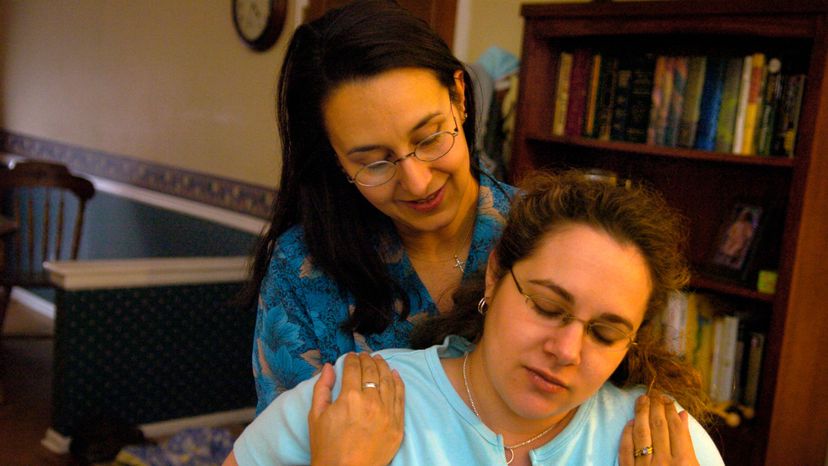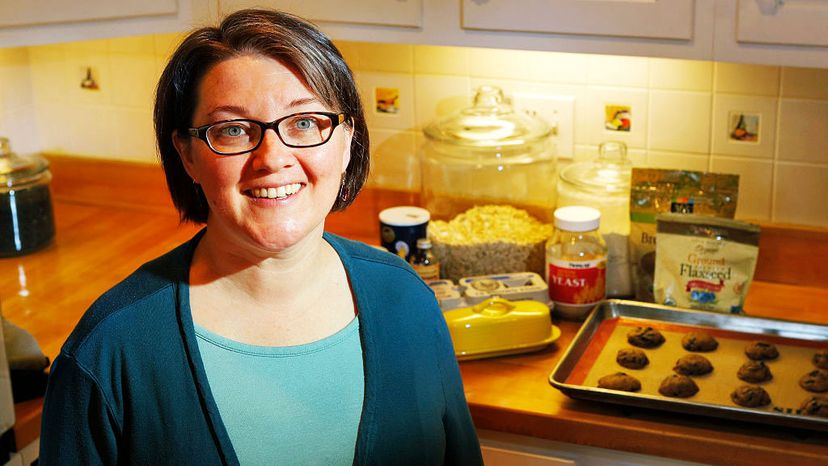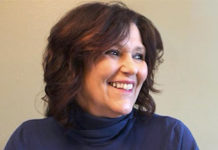 “Certified labor doula Ana Hill helps Leanne Stiles prepare for her upcoming birth. Hill assisted Stiles during her first pregnancy too. Karl Gehring/The Denver Post via Getty Images
“Certified labor doula Ana Hill helps Leanne Stiles prepare for her upcoming birth. Hill assisted Stiles during her first pregnancy too. Karl Gehring/The Denver Post via Getty Images
The childbirth experience has undergone total transformation since the days of dads hanging out in waiting rooms proudly handing out his pink or blue cigars. Since the 1970s, fathers have been allowed in the delivery room, followed later by other family members and even friends. Nowadays, a mom may have even more company in the delivery room, with a doula by her side.
The word doula is Greek for "female slave," or "female servant" but the true scope of a doula’s responsibilities is far greater than wiping a woman’s brow and fetching ice chips. In fact, doulas are trained childbirth coaches whom expectant, laboring and postpartum mothers turn to for educational, physical and emotional support. Due to the nature of the business, the vast majority of doulas are women who’ve given birth themselves, although men certainly can take up this line of work [source: Rochman].
The term "doula" was assigned to the emerging field in 1976, but the career path didn’t gain traction until the 1980s. This increase in doula use was due to a rising incidence of cesarean sections (C-sections). In response, mothers-to-be started having a trusted woman in the room, like a childbirth instructor or nurse friend, to serve as their labor and delivery advocate. The idea was for those advocates to help prevent unnecessary, often routine procedures known to lead to C-sections [source: Papagni].
Today, more pending parents are enlisting the help of doulas than ever before, with 6 percent of people surveyed in 2012 reporting that they employed a doula, a marked increase from 3 percent in 2006. What’s more, 27 percent of those surveyed indicated that they’d like to use a doula [source: Declerq et al.].
"A doula is very skilled in the area of empathy for what often feels like a monumental task," explains certified birth and postpartum doula Jenny Bennett who owns Expecting the Best Birth in the Washington D.C. area. "Doulas have competency in the area of facilitating conversation between clients and providers, so if there’s a need for clarification or additional facts in order to make an informed choice about a drug or a procedure, we can help," she says via email.
Even though doulas have been in the U.S. for more than three decades, there’s still quite a bit of confusion about what they do. Keep reading to find out more.
Contents
- What Doulas Do (and Don't Do)
- Becoming a Doula
- Why Use a Doula?
- Choosing a Doula
What Doulas Do (and Don't Do)
 “Ashley nurses her newborn son, Isaac, as the doula who ended up delivering the baby, background, keeps a watchful eye over them. Student midwife Jessica Lockwood (L), takes Ashley’s blood pressure. Jessica Rinaldi/The Boston Globe via Getty Images
“Ashley nurses her newborn son, Isaac, as the doula who ended up delivering the baby, background, keeps a watchful eye over them. Student midwife Jessica Lockwood (L), takes Ashley’s blood pressure. Jessica Rinaldi/The Boston Globe via Getty Images
If you’re about to give birth, don’t go firing your midwife or obstetrician just yet. Probably the most common misconception is that doulas deliver babies. In fact, they are not able to perform any type of medical function. "If there is any medical element, be it a syringe, an IV or a heart rate monitor for instance, a doctor, midwife or a nurse will handle that," Bennett says. "But we do hold your hand and help you breathe while these things are being administered, because they can be uncomfortable or bothersome, especially when you are having contractions. Doulas help to ease that."
Doulas should be knowledgeable about medical procedures to the point where they can explain risks, benefits, alternatives and why they’re done, but the doula cannot make the decision, pressure a mother into a decision or even give direct advice. Doulas should also avoid contradicting the advice of providers, as they are the trained medical care professionals [source: International Childbirth Education Association].
Medical limitations aside, doulas serve pretty important functions. They typically meet with clients before birth to answer questions, address concerns and equip parents with coping techniques, especially related to pain management.
"We provide a listening ear for any concerns that may come up during pregnancy, anything from fear about birth to the physical discomfort of growing and carrying a small human for nine months," Bennet explains. "We help clients prepare for the birth in whatever ways they are most inclined to do so. So, if using medications is the route you want to go, we are knowledgeable about which options are available in which birthing facilities and help you think about the best times during your labor process to receive those medications, how they work and what to expect, whether you desire to go early on in labor or stay at home for a little while."
And although the common belief is that doula-involved births are done without pharmaceutical intervention, that’s actually not the case. "We share information about alternatives to pharmaceutical pain relief such as water birth, sterile water papules for back pressure, movement, positioning, vocalization, and other specialized techniques, some of which continue to be very comforting even when epidurals are used," Bennett explains.
During labor, a doula gives emotional and physical support to the mother. She ensures that mom gets enough water/fluids and employs pain and stress relief measures like heat or cold therapy. The doula also coaches the mother through pain, using coping skills like visualization, relaxing touch and breathing techniques. A doula can also suggest position changes that help the laboring mother-to-be handle the discomfort and progress in labor [source: International Childbirth Education Association].
Doulas are not intended to replace the father or co-parent during the labor and delivery process. Instead, they should complement and support him and others present for the birth, as well. After the birth, doulas usually assist with first feedings and bonding efforts. Many also work with mothers postpartum to facilitate healing, and consult throughout the often-complicated breastfeeding process [source: National Partnership for Women and Families].
Midwifes vs. Doulas
Certified nurse-midwives go through more rigorous training than doulas because they perform medical tasks, but are not as credentialed as doctors. They must complete advanced clinical nursing training, and usually have earned a master of science degree in nursing. Plus, they are required to pass a certification exam. As a result, they can deliver babies, but defer to M.D.s if delivery dictates. Direct entry midwives are not trained nurses, but have learned about midwifery through self-study, classes or an apprenticeship. They are more likely to attend home births and may need to be licensed, depending on the state they live in [source: American Pregnancy Association].
Becoming a Doula
 “Jessica Thomas provides postpartum doula care for new parents through her business Ballast & Buoy in Portland, Maine. Gregory Rec/Portland Press Herald via Getty Images
“Jessica Thomas provides postpartum doula care for new parents through her business Ballast & Buoy in Portland, Maine. Gregory Rec/Portland Press Herald via Getty Images
Like many careers, life as a doula can be rewarding and challenging. "Long hours and the general stress of the hospital environment are two of the biggest challenges," Bennett explains, which makes sense since laboring mothers can take many hours to deliver, and typically a doula sticks around for most, or all, of the process. However, "Seeing new life come into the world and watching the expressions on the new parents’ faces never gets old!" she adds.
Now for the nitty-gritty details. Doulas do not have to have a high school or college degree. In fact, Childbirth Professionals International hold that being a doula is a great way for someone to work their way through school. Although doulas do not have to be certified or licensed, it’s definitely a professional boon to go through a training course. Reputable organizations include DONA International, Doula Trainings International and CAPPA. Many organizations offer both online and in-person classes, and require a certain number of hours and births be completed as a student before certification is achieved (requirements vary by program). Training time also varies. Childbirth Professionals International’s program includes 16 hours of class time, self-paced study, a childbirth class and a breastfeeding class, as well as attending two births before a certificate is given.
The doula pay rate varies widely and is usually based on where the services are being provided. Some geographic areas are more expensive to live and work in, and thus rates in those places will be higher. According to DONA International, the world’s first doula certifying organization, a DONA-certified doula’s fee was on average $653-$844 for a birth in 2016. A non-certified doula’s fee was $494-$708 [source: James].
Doulas can be salaried or freelance professionals. Some hospitals and community groups keep doulas on staff, or a doula can get clients by working with community groups, public health agencies, referral agencies, doctor’s offices or word of mouth.
There are several types of doulas. Most are labor doulas, who are present during labor and delivery. However, there are also antepartum doulas who are skilled at providing support to mothers having high-risk pregnancies, or who have been put on bed rest. By contrast, postpartum doulas are helpful in the first weeks post-birth. They provide direction about caring for the baby and feeding him, and also give emotional backup to overwhelmed mothers. Some even complete physical tasks, like cooking meals, and cleaning and caring for the infant [source: American Pregnancy Association]. And some doulas offer special support for women experiencing abortion, miscarriage or adoption [source: The Radical Doula].
Death Doulas
Doulas aren’t just for the beginning of life – they can also make the end easier, too. End-of-life doulas guide the dying and their loved ones through the final days of life by giving emotional, physical and spiritual support during a difficult time. Visit the International End of Life Doula Association’s online directory to locate such a professional.
Why Use a Doula?
 “A doula comforts her emotional pregnant client as she lays in the operating theatre during a Caesarean section. Petri Oeschger/Getty Images
“A doula comforts her emotional pregnant client as she lays in the operating theatre during a Caesarean section. Petri Oeschger/Getty Images
Traditionally, women relied on female relatives and friends to help them though the birthing process. But as births move into hospitals in the 20th century, many of these functions were handed over to nurses. As electronic monitoring became prevalent, nurses didn’t have to stay with one patient and usually had several to attend to at one time. This often left the mother feeling lonely and unsupported. Even if she had her husband, partner or a friend in the birthing room with her, they may not know the best way to assist her [source: Papagni]. Enter the need for a doula.
Doulas might not be technically necessary to the childbirth process, but many parents consider them essential nonetheless. Science appears to be backing that sentiment, too. A recent review of studies looked at the birth results of more than 15,000 people. Some of the birthing mothers had continuous support, like doulas, nurses or friends/family members. Other women had no continuous support at all. Outcomes for women with continuous support were better than those without. Their labors were shorter, on average, by 40 minutes and their babies tended to have higher Apgar scores (scores used to assess the baby’s health at birth). They experienced fewer negative feelings about childbirth and required less pain medication, forceps or vacuum-assisted interventions and C-sections. No disadvantages to continuous support were found whatsoever [source: Bohren et al.]
The researchers then looked specifically at care by a doula to see how it compared with other types of continuous care. Women who used a doula were 31 percent less likely to use Pitocin and 28 percent less likely to have a C-section. They were also 12 percent more likely to have a spontaneous vaginal delivery and their infants enjoyed 14 percent less risk of needing to be admitted to a special care nursery. In many of these categories, doulas outperformed other types of continuous care providers [source: Dekker].
If you’re wondering why/how doulas are able to achieve these statistical feats, consider how Bennett likens them to "professional nurturers," insisting that they serve to complement the typical group of nurses, doctors, midwives and other medical professionals. "I’ve run across some very compassionate doctors, midwives and nurses in my day, the more compassion around you the better, but they need to reserve a lot of mental capacity for their medical roles," she explains. "They have very demanding jobs and so doulas are there to lessen that burden by comforting our clients and helping them to have a positive experience."
This is in line with the harsh environment theory, which holds that the many sights, sounds and experiences of the hospital setting make it more difficult for laboring mothers to have great outcomes. The severe lighting, procedures and presence of virtual strangers causes lagging self-confidence (pretty important when in the midst of a difficult feat) and can even slow labor. So, the presence of a knowledgeable advocate can lessen the harshness of the experience. The constant support and supplication of pain management techniques can also effectively reduce pain levels, essentially turning the doula herself into a powerful, human pain-reliever.
Choosing a Doula
Finding a reputable doula is easy enough if you know where to look. Organizations like DONA International, CAPPA and American Pregnancy Association can provide lists of doulas local to you, or you can always get a personal reference from a friend.
When you’ve narrowed your potential doula list down, it’s time to do some interviews. Be sure to inquire about their training, services, availability around your due date, childbirth philosophy and how they’d handle it if for some reason they’re not available to be at the birth. Don’t forget to ask for references — and check them.
Fees are another major concern for many parents-to-be. Childbirth expenses, even with insurance, can be daunting. If you live in a major metropolitan area, like Los Angeles or New York, you can expect to pay more for a doula than someone in a less expensive locale [source: Port].
Certain insurance plans have added some doula coverage, so make that your first inquiry. How much will they cover, and which services? If your insurance offers zero or limited coverage, consider sending in a letter spelling out the many ways that doulas reduce costs for patient and insurer (fewer tests, medications and other interventions), actually saving insurance companies money in the short and long-term. It won’t hurt anything to submit a claim, and you might be surprised by the end result!
If you want to encourage insurance policy reform, consider working with groups like Lamaze International and the National Partnership for Women and Families and Choices in Childbirth to encourage enlightened conversation and spark change.
In the meantime, if your insurance offers little or no coverage and you can’t foot the bill out of pocket, there are other options. Some doulas offer discounted services to parents with limited financial resources [source: Childbirth Connection]. Also, doulas-in-training typically work for free to get experience, plus some volunteer doula organizations provide pro bono help, as well.
Lots More Information
Author’s Note: How Doulas Work
I’ve given birth to three strapping baby boys, and I can certainly see how having a doula involved could have made the experiences easier. I particularly think the postpartum period would have been less stressful with such a person "on staff," so to speak. Dealing with breastfeeding, physical recovery, hormone shifts and the myriad other post-birth phenomena is challenging, to say the least. A new mom can use all the help she can get!
Related Articles
- How Childbirth Works
- How Midwives Work
- What’s the difference between a midwife and a doula?
- Choosing an Ob-Gyn While Pregnant
More Great Links
- Expecting the Best Birth
- Hypnobabies
- Doula Trainings International
Sources
- All Nursing Schools. "Differences Between a Doula and a Midwife." 2017 (Oct. 13, 2017) https://www.allnursingschools.com/articles/doula/
- American Pregnancy Association. "Having a Doula: Is a Doula for Me?" 2017 (Oct. 22, 2017) http://americanpregnancy.org/labor-and-birth/having-a-doula/
- Bennett, Jenny. Email Interview, Sept. 25, 2017. http://expectingthebestbirth.com
- Bennett, Jenny. Email Interview, Sept. 25, 2017. http://expectingthebestbirth.com Director of childbirth education for DTI // credentials: CD (DTI), HCHI (Hypnobabies) — CD is certified birth & postpartum doula and HCHI is Hypnobabies childbirth hypnosis instructor
- Childbirth Connection. "What if I want to work with a doula and cost is an issue?" 2017 (Oct. 11, 2017) http://www.childbirthconnection.org/giving-birth/labor-support/support-specialist-doula/working-with-specialist/doula-cost.html
- Childbirth Professionals International "Questions About Becoming a Doula." 2017 (Oct. 13, 2017) https://thechildbirthprofession.com/top-10-questions-about-becoming-a-doula/
- Dekker, Rebecca. "Evidence on: Doulas." Aug. 14, 2017 (Oct. 12, 2017) https://evidencebasedbirth.com/the-evidence-for-doulas/
- INELDA. "Make a Difference." 2017 (Oct. 10, 2017) http://inelda.org/
- International Childbirth Education Association. "The Role and Scope of Birth Doula Practice." Oct. 2015 (Oct. 11, 2017) http://icea.org/wp-content/uploads/2016/01/Role_Scope_Doula_PP.pdf
- Hodnett ED1, Gates S, Hofmeyr GJ, Sakala C. "Continous Support for Women During Childbirth." Cochrane Database System Review. July 15, 2013 (Oct. 11, 2017) https://www.ncbi.nlm.nih.gov/pubmed/28681500
- James, Kim. "Certification Still Matters: DONA Certified Doulas Earn Higher Fees & Attract More Clients." DONA International. July 23, 2016 (Oct. 11, 2017) https://www.dona.org/certification-still-matters-certified-doulas-earn-higher-fees-and-attract-more-clients/
- National Partnership for Women and Families. "Overdue: Medicaid and Private Insurance Coverage of Doula Care to Strengthen Maternal and Infant Health." Jan. 2016 (Oct. 12, 2017) http://www.nationalpartnership.org/research-library/maternal-health/overdue-medicaid-and-private-insurance-coverage-of-doula-care-to-strengthen-maternal-and-infant-health-issue-brief.pdf
- Papagni, Karla and Ellen Buckner. "Doula Support and Attitudes of Intrapartum Nurses: A Qualitative Study from the Patient’s Perspective." Journal of Perinatal Education. Winter 2006 (Oct. 10, 2017) https://www.ncbi.nlm.nih.gov/pmc/articles/PMC1595283/
- Port, Dina Roth. "How Much Do Doulas Cost?" Parents. 2014 (Oct. 10, 2017) http://www.parents.com/pregnancy/giving-birth/doula/how-much-do-doulas-cost/
- Rochman, Bonnie. "Men at Work for Women in Labor." New York Times. Dec. 2, 2013 (Oct. 10, 2017) https://well.blogs.nytimes.com/2013/12/02/men-at-work-for-women-in-labor/































